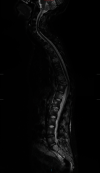Management Challenges of Metastatic Spinal Cord Compression in Pregnancy
- PMID: 33204568
- PMCID: PMC7652620
- DOI: 10.1155/2020/8891021
Management Challenges of Metastatic Spinal Cord Compression in Pregnancy
Abstract
Primary and secondary spinal tumours with cord compression often represent a challenging condition for the patient and clinicians alike, even more so during pregnancy. The balance between safe delivery of a healthy baby and management of the mother's disease bears many clinical, psychological, and ethical dilemmas. Pregnancy sets a conflict between the optimal surgical and oncological managements of the mother's tumour and the well-being of her foetus. We followed the CARE guidelines from the EQUATOR Network to report an exemplificative case of a 39-year-old woman with a 10-year history of breast cancer, presenting in the second trimester of her first pregnancy with acute onset severe thoracic spinal instability, causing mechanical pain and weakness in lower limbs. Neuroradiological investigations revealed multilevel spinal deposits with a pathological T10 fracture responsible for spinal cord compression. The patient was adamant that she wanted a continuation of the pregnancy and her baby delivered. After discussion with her oncologist and obstetrician, we agreed to perform emergency spinal surgery-decompression and instrumented fixation. The literature search did not reveal a similar case of spinal metastatic breast cancer undergoing spinal instrumentation and delivery of a healthy baby a few months later. Following the delivery, the patient had further oncological treatment, including chemotherapy and radiotherapy. The paucity of such reports prompted us to present this case and highlight the relevance of a multidisciplinary approach involving obstetrician, oncologist, spinal surgeon, and radiologist to guide the optimal decision-making process.
Copyright © 2020 Davor Dasic et al.
Conflict of interest statement
The authors declare that they have no conflicts of interest.
Figures







Similar articles
-
British Association of Surgical Oncology Guidelines. The management of metastatic bone disease in the United Kingdom. The Breast Specialty Group of the British Association of Surgical Oncology.Eur J Surg Oncol. 1999 Feb;25(1):3-23. Eur J Surg Oncol. 1999. PMID: 10188849 Review.
-
Respecting the autonomy of chronic mentally ill women in decisions about contraception.Hosp Community Psychiatry. 1993 Jul;44(7):671-4. doi: 10.1176/ps.44.7.671. Hosp Community Psychiatry. 1993. PMID: 8354506
-
Antepartum surgical management of Pott's paraplegia along with maintenance of pregnancy during second trimester.Eur Spine J. 2016 Apr;25(4):1064-9. doi: 10.1007/s00586-015-4045-4. Epub 2015 Jun 25. Eur Spine J. 2016. PMID: 26108387 Review.
-
Aggressive plasmablastic lymphoma of the thoracic spine presenting as acute spinal cord compression in a case of asymptomatic undiagnosed human immunodeficiency virus infection.Spine J. 2014 Jul 1;14(7):e1-5. doi: 10.1016/j.spinee.2013.12.018. Epub 2013 Dec 20. Spine J. 2014. PMID: 24362000
-
Improvement of Metastatic Spinal Cord Compression After Decompression Surgery and Radiotherapy in a Patient Initially Treated for Rectal Cancer.Cureus. 2022 Jan 11;14(1):e21134. doi: 10.7759/cureus.21134. eCollection 2022 Jan. Cureus. 2022. PMID: 35186512 Free PMC article.
Cited by
-
A Rare Metastatic Site of Invasive Lobular Breast Carcinoma: A Case Report.Case Rep Surg. 2021 Nov 22;2021:9922296. doi: 10.1155/2021/9922296. eCollection 2021. Case Rep Surg. 2021. PMID: 34853710 Free PMC article.
References
-
- Kennedy S., Yudkin P., Greenall M. Cancer in pregnancy. European Journal of Surgical Oncology. 1993;19(5):405–407. - PubMed
-
- Murphey G. P. CA-Cancer statistics. CA. 1999;49:20–21.
Publication types
LinkOut - more resources
Full Text Sources
Research Materials

